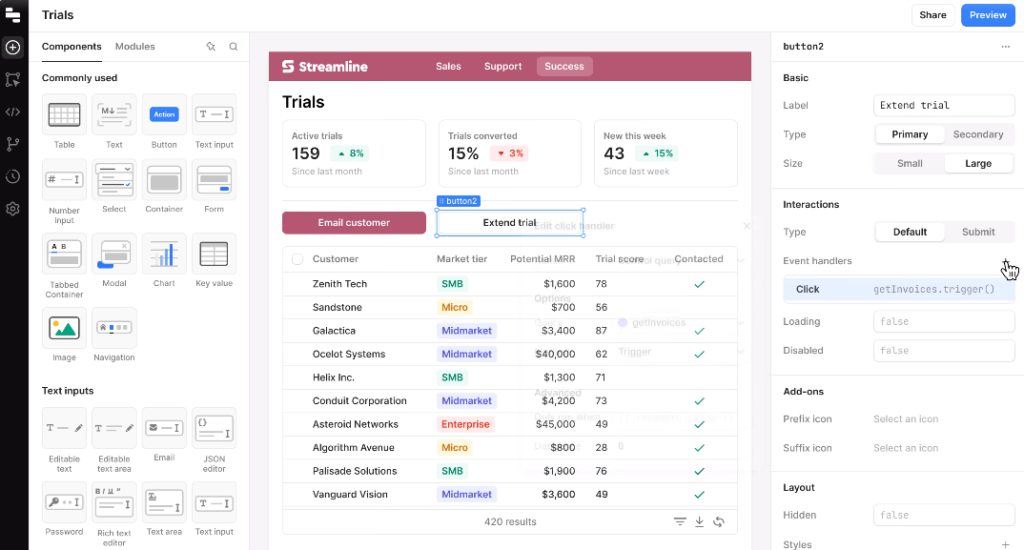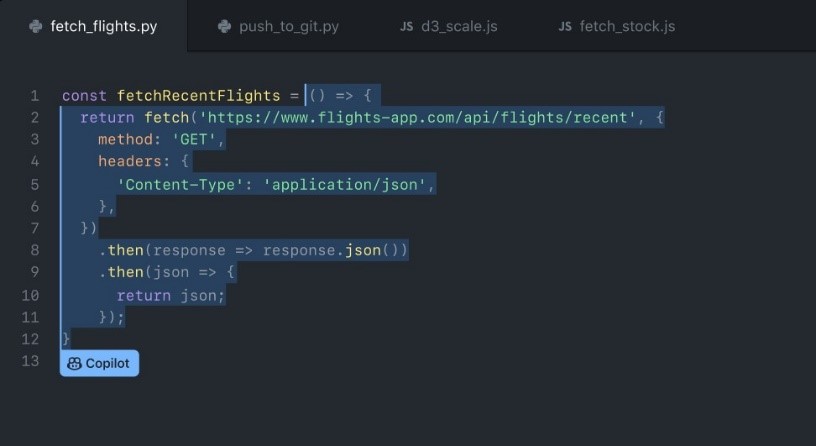Low-code tools and AI in ecommerce: the next game-changer?
Are we on the verge of getting the next big game-changer in the ecommerce sector (and beyond)? The use of low-code applications combined with artificial intelligence in ecommerce is a promising direction of development that contributes to significant improvement in multiple aspects of online trade. In this article, we want to show you how low-code tools boosted by AI in ecommerce can make your work easier, faster and cheaper.
Traditional development vs. low-code technology and AI
The traditional app development process involves a lot of coding – that’s why you need web/mobile developers working on your apps and tools for you. Things changed a bit recently, though. Now, we have access to low-code tools and platforms that enable the creation of digital tools using visual interfaces rather than code.
These platforms allow users to design and build functional applications using drag-and-drop editors, pre-built templates and ready-made configuration settings. This means that the actual coding is minimised, and in some cases, you don’t need to know any coding languages at all!
Let’s use a simple example – about 4-5 years ago, if you wanted to design and publish a new website, you needed to write every single line of code manually. Today, there are many super-intuitive CMS systems (e.g., Wix or Squarespace) with ready-made components. All you have to do is design the visual layer. This way, you can create a beautiful and functional website even if the term HTML doesn’t even ring a bell.
It’s the same story with mobile and web apps and tools. Thanks to low-code platforms, you can create your own tool or implement ecommerce automation even if you are not a pro. Additionally, the use of AI in ecommerce allows for the automation of many aspects of online trade, including:
• Personalisation of shopping experiences
• Smart product recommendations
• Efficient inventory management
AI works here like a catalyst that analyses data related to customer behaviour and uses this input to provide your customers with better UX.
Today, AI streamlines the code-writing process and will soon be able to quickly generate applications on its own, for example, for data integration purposes. This synergy of low-code and AI enables ecommerce companies to shorten the cycle of delivering new solutions to the market, improving efficiency and flexibility, as well as reducing application development costs. However, to be successful, it is crucial to thoroughly understand your business needs and focus on delivering value to your customers using these advanced tools.
The right approach to low-code AI development
All the modern ecommerce trends focus on one crucial element – UX. With hundreds of stores offering the exact same products, UX is your best differentiator, enabling you to stand out from the crowd. And without a doubt, low-code platforms can help you achieve this goal.
However, what’s important is to focus on your customer experiences. Low-code platforms should help you serve your customers better, not just save time and money. Of course, you can still kill two birds with one stone, but UX should always be your primary concern. Only this way will your store continue to flourish.
Additionally, keep in mind that ready-made solutions are primarily for small and medium-sized players who don’t have the budget to develop everything from scratch. Big companies with complex and extensive needs should stick to traditional development.
Examples of AI-powered low-code platforms
Currently, low-code and no-code platforms are just mushrooming. The choice is very broad, and it’s almost impossible to list all the solutions available out there. However, we want to show you a few such platforms:
ADOBE APP BUILDER
This platform is a part of the Adobe Experience Manager. It enables you to easily build custom microservices and single-page applications (SPAs) to meet your business needs. With App Builder, you can connect your online store to a third-party system or build a specialised pipeline.

Source: https://business.adobe.com/products/experience-manager/developer-app-builder.html
BUBBLE.IO
This platform advertises itself as the world’s only full-stack, no-code platform. With Bubble, you can design, develop and launch production-grade applications and tools without the need to write a single line of code. As of November 2023, over 3 million apps are built using this platform, and Bubble offers over 6 thousand integrations with other tools.

Source: https://bubble.io/
RETOOL
Retool is a platform that allows users to build internal tools for their businesses without having to write code from scratch. It provides a drag-and-drop interface to create and customise various tools, interfaces, and dashboards by connecting to different data sources like databases, APIs, and more. Essentially, it enables teams to rapidly build and deploy internal tools, saving time and resources typically required for software development. It also allows integrating AI into apps and workflows with pre-built blocks.

Source: https://retool.com
GITHUB COPILOT
It’s another low-code AI-powered platform developed by GitHub in cooperation with Microsoft. This platform uses the OpenAI Codex to suggest code and entire functions in real-time, right from the editor. According to their own research, developers using GitHub Copilot code up to 55% faster and feel more confident about the process.

Source: https://resources.github.com/copilot-for-business/
What can you develop with low-code AI development?
The answer is more and more. Low-code platforms, as well as AI tools, are improving dynamically. What was unimaginable just five years ago is completely normal today. Of course, ChatGPT was a huge game-changer. Today, the 4.0 version can help you even write code from scratch for your ecommerce application.
In the near future, low-code platforms will be integrated with ChatGPT and other LLMs to give you this fantastic opportunity to just describe what you need and get it in a matter of minutes. Today, though, low-code platforms use artificial intelligence to streamline the process and provide you with real-time suggestions on what you can do to make your tool or app better.
Imagine, for instance, that you run a clothing online store and you want to integrate a ChatGPT-based assistant with your product search engine. This way, when someone looks for shirts, the assistant can ask them about the preferred colour or size. Moreover, the same platform that helped you design such an assistant can suggest you add a cross-selling feature so that your bot assistant can also advise your customers to also buy a tie or cufflinks that will go nicely with a chosen shirt.
In this example, the AI-powered assistant was designed primarily to help your customers. Naturally, you as a store owner also benefit because this assistant can help you increase sales, but that’s more of a side benefit. And that’s how you should think about low-code AI development and ecommerce automation in general.
What else can you design with those low-code platforms?
• Smart product recommendation tools (AI can suggest products based on each customer’s shopping history and searched products)
• Stand-alone virtual assistants (chatbots don’t have to be integrated with the search engine; they can operate within your entire website and even social media profiles and support your omnichannel efforts)
• Inventory management and planning (you can use AI algorithms for demand forecasting to optimise inventory levels, reducing the probability of lack of goods or overstock)
• Cross-selling and upselling tools (you can recommend your customers to add complementary tools to the cart or suggest they consider a higher model/version of the product they picked)
• Smart search (you can make your search engine more effective by adding more search options, e.g., visual search)
And these are just a few examples – with the support of a professional ecommerce development company, there are almost no limits to what you can design.
The benefits of using low-code AI in ecommerce
There is one crucial advantage of using low-code AI development – speed. Low-code platforms provide users with drag-and-drop editors that offer ready-made or at least pre-configured solutions and pieces of code. With such a flexible environment, you can quickly implement and test new solutions and see how they work in practice.
You can also implement minor changes and new solutions without the need to involve your development team in the process. And lastly, with advanced language models such as ChatGPT, you can even get suggestions on what to improve or implement to make your app more useful from your customers’ perspective.
This way, you can go out of your “technological bubble” and fully adapt your online store, along with its features and processes, to what your customers expect. And that’s how we circle back to what we discussed in the beginning – UX should be your primary concern. Our advice is for you to use those solutions to guide your customers within the context they exist in – show them where they are, where they were and what you can give them – that’s the key to next-level personalisation that will allow your store to get ahead.
With those low-code AI platforms, you can have a fully operational tool or plugin in a few weeks. Such a short time to market means you can quickly react to changes in the market and new trends.
A shorter time to market also means that the development cost is significantly lower compared to standard development (by the way, the cost of potential errors and mistakes is also lower, so your company can more actively test new solutions).
Overall, using low-code tools and AI in ecommerce makes the cost of ownership significantly lower due to reduced development, maintenance and training costs, along with faster deployment and easier scalability.
Challenges to consider
Lastly, we’d like to say a few more words about potential challenges. First off, keep in mind that low-code platforms are now super-popular. Pick the one that’s more likely to stay on the market for longer than a few weeks.
Secondly, don’t go overboard with low-code AI. If you implement this solution in everything you do, there is a serious risk that the quality of your company and its operations will go down. Don’t overcomplicate; if something can be achieved with standard development techniques, stick to them.
Furthermore, it’s important to have some sort of a control mechanism – every single time, you should look at the big picture and ask yourself these questions:
• Does it make any sense?
• How much time will it take?
• Can we streamline this process?
• Is there a better/faster/easier way to achieve the same result?
Lastly, you need to define your long-term vision and pursue it in whatever you do concerning low-code AI platforms. Naturally, you won’t solve all of those problems yourself. You probably still need a web development partner that understands AI and supports you in your digital projects.
If you are still looking for such an ecommerce development partner – we are at your service!
About the author
Recommended articles
CONTACT




